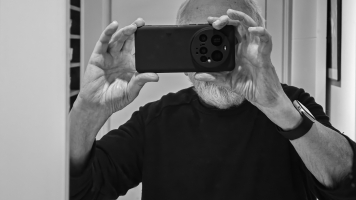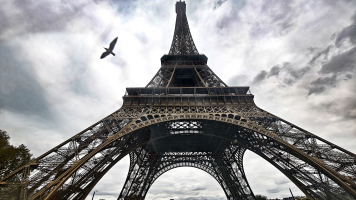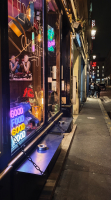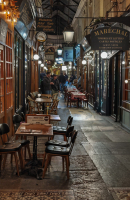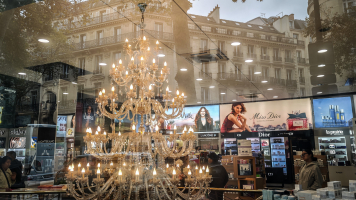Wenn der Erdschatten den Vollmond verdunkelt, wird der Trabant rot
English version at the end of this report
Die Bilderserie zum Thema Blutmond findenSie hier
Blaue Nächte sind im Hafen von Hamburg (oder auch St. Pauli) nicht wirklich eine Seltenheit. Doch dass der sonst eher gelb-weiß schimmernde Mond bei seiner Wanderung über das Hafengelände plötzlich in roten Tönen erscheint, das kommt eher selten vor. Am 7. September 2025 war es mal wieder soweit; mehr als drei Jahre nach der letzten Naturerscheinung dieser Art. Anders als 2022 war die blaue Nacht am Hafen an diesem Abend wirklich einmal schön Blau und wolkenlos. Doch dann schien der Erdtrabant – das Lieblingsobjekt aller deutschen Romantiker – erst einmal auf sich warten zu lassen. Erst um 20:33 Uhr tauchte die eher dürftig rote Scheibe endlich auf. Unmittelbar über dem Dach der mächtigen Elbphilharmonie erhob sie sich fast schüchtern, um sich dann in den nächsten 60 Minuten weiter zu erheben und auf den Weg über das Hafengelände mit seinen Trockendocks und gigantischen Schiffskrähnen zu machen.
Noch ist die Erde bewohnbarer als der Mond
Mit jeder Minute wurde der Erdtrabant heller, das Rot intensiver und die Nacht dunkler. Schließlich, der Erddrehung geschuldet, erhellte das erste Sonnenlicht die (Verzeihung, Ihr Astronomen und Mond-Liebhaber!!) Unterkante des riesigen Satelliten derart stark, dass der Himmelskörper mit normalen Methoden kaum noch zu fotografieren war. Gleichzeitig wurde La Luna immer heller, bis sie wieder gelb-weiß bis bleich ihre Bahn über den Hafen zog. Da ich diesen Teil des Phänomens Blutmond schon vor drei Jahren bei attraktiveren Wetterbedingungen fotografiert hatte, ersparte ich mir diesen Teil der Mondreise und zeige die 2022 entstandenen Bilder hier erstmals. Für mich bewies die Rote Nacht am blauen Hafen einmal mehr, dass der Schriftsteller Gerhard Zwerenz mit seinem Vergleich “Die Erde ist unbewohnbar wie der Mond” gründlich daneben lag.
Wie der Blutmond zustande kommt
Wenn der Mond bei seiner Umkreisung der Erde in den vollen Schatten unseres Planeten tritt und gerade zusätzlich noch Vollmond herrscht, kommt es eigentlich zu einer vollständigen Mondfinsternis. Doch das stimmt leider nicht ganz so. Denn eine vollständige Mondfinsterniss bedeutete ja eigentlich, dass unser Trabant plötzlich für eine bestimmte Dauer seiner Umkreisung vollständig unsichtbar wäre. Doch diesen Gefallen tut uns die Sonne nicht. Auch wenn sich unser Planet breit und bräßig direkt zwischen Sonne und Mond schiebt, kann sich der Liebling romantischer Lyriker und anderer Schwärmer nicht vollständig verstecken, denn am Rand des Erdschattens kommen immer noch Sonnenstrahlen durch, die wir aber nur bemerken, wenn sie auf den Mond treffen. Nach maximal 106 Minuten ist der Blutmond aber sowieso immer wieder Vergangenheit, und die Mond-Fans sinken seufzend ins Bett!! (aber schön ist das Schauspiel doch, oder??!!)
________________________________
English translation:
When the Earth’s shadow darkens the full moon, the satellite turns red
English version at the end of this report
You can find the series of images on the topic of blood moons here
Blue nights are not really a rarity in the port of Hamburg (or St. Pauli). But it is rather rare for the moon, which usually shimmers yellow and white, to suddenly appear in shades of red as it travels across the harbor. On September 7, 2025, it happened again, more than three years after the last natural phenomenon of this kind. Unlike in 2022, the blue night at the harbor that evening was truly beautiful, blue and cloudless. But then the Earth’s satellite – the favorite object of all German romantics – seemed to be taking its time. It was not until 8:33 p.m. that the rather faint red disc finally appeared. It rose almost shyly directly above the roof of the mighty Elbphilharmonie concert hall, then continued to rise over the next 60 minutes, making its way across the harbor area with its dry docks and gigantic ship cranes.
The Earth is still more habitable than the Moon
With each passing minute, the Earth’s satellite became brighter, the red more intense, and the night darker. Finally, due to the Earth’s rotation, the first sunlight illuminated the (forgive me, astronomers and moon lovers!) lower edge of the giant satellite so strongly that it was almost impossible to photograph the celestial body using normal methods. At the same time, La Luna grew brighter and brighter until it once again traced its yellow-white to pale path across the harbor. Since I had already photographed this part of the blood moon phenomenon three years ago in more favorable weather conditions, I spared myself this part of the moon journey and am showing the 2022 images here for the first time. For me, the red night at the blue harbor proved once again that the writer Gerhard Zwerenz was completely wrong with his comparison “The Earth is as uninhabitable as the moon.”
How the blood moon comes about
When the moon enters the full shadow of our planet as it orbits the Earth and it is also a full moon, a total lunar eclipse actually occurs. Unfortunately, this is not entirely true. A total lunar eclipse would actually mean that our satellite would suddenly be completely invisible for a certain period of its orbit. But the sun does not do us this favor. Even when our planet moves directly between the sun and the moon, the darling of romantic poets and other dreamers cannot hide completely, because sunbeams still shine through at the edge of the Earth’s shadow, which we only notice when they hit the moon. After a maximum of 106 minutes, however, the blood moon is always a thing of the past, and moon fans sink into bed with a sigh! (But it’s a beautiful spectacle, isn’t it?!)




